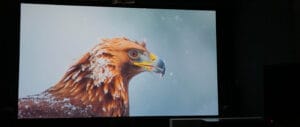Projector Screen vs Paint: What’s Right for You?
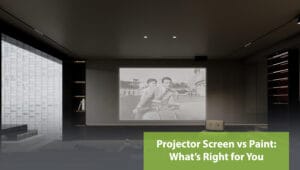
- Introduction
- What Is Projector Screen Paint?
- Projector Screen vs Paint - Comparison
- Using Paint Instead of a Projector Screen
- Where Can Projection Paint Be Used?
- Is Projector Screen Paint Worth It?
- Types of Projector Screen Paints
- Projector Screen vs Wall
- Making the Right Choice
- Final Words
When it comes to creating the perfect projection surface, the debate between projector screens and projector screen paints is becoming increasingly common. Businesses, educators, and homeowners alike are exploring both options to determine which delivers the best balance of performance, flexibility, and cost-effectiveness.
Traditional projector screens have long been the standard, but the rise of projector screen paints has introduced a modern alternative that promises more adaptability and sleek, space-saving designs.
In this guide, we’ll examine projection paint vs projector screen in detail, compare their benefits, and help you decide which option aligns best with your needs, whether it’s for a classroom, office, home theatre, or even an outdoor setup.
What Is Projector Screen Paint?
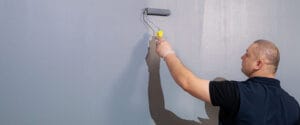
Projector screen paint is a specialized coating designed to transform any smooth surface into a high-quality projection screen. Unlike regular household paint, projector screen paint is engineered with advanced reflective technology to optimize light return, improve brightness, and enhance image contrast. In recent years the technology has evolved changing the technical performance significantly.
The primary difference between projector screen paint and normal paint lies in performance. Standard wall paint has a gain value of around 1.0 while scattering the projected light poorly offering little enhancement to projected images. In contrast, projector screen paints can offer higher gain values, ambient light rejection or even contrast optimization depending on the type you choose. This makes them an efficient solution for users who need professional-grade projection without the bulk of a traditional screen.
From corporate meeting rooms to home cinemas, projector screen paint allows users to maximize space while achieving a tailored projection experience.
Projector Screen vs Paint - Comparison
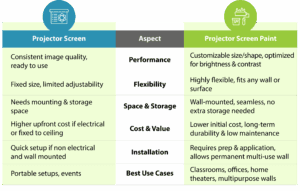
When deciding between a traditional projector screen and a projector screen paint, it’s important to consider performance, flexibility, and long-term usability. Screens provide consistent image quality and are quick to set up, making them a reliable choice for events or temporary setups.
However, they are limited by their fixed sizes and require mounting and storage space, which can restrict adaptability in modern classrooms, offices, or home theatres.
In contrast, projector screen paint allows for a customized projection area of any size or shape, giving walls a sleek, multifunctional purpose. It eliminates the need for bulky screens and storage while offering a clean, integrated look. Depending on your space and usage needs, projector paint can provide greater flexibility, durability, and long-term value compared to traditional screens.
Using Paint Instead of a Projector Screen
The paint can absolutely replace a traditional projector screen, provided it is designed for projection. Projector screen paints are manufactured with properties that enhance colour accuracy, contrast, and brightness, ensuring they perform as well as, if not better than, standard projector screens.
For example, Ambient Light Rejecting (ALR) Paint is specifically formulated to minimize the effects of external light sources, maintaining crisp visuals even in brightly lit rooms. Black Projector Screen Paint excels in delivering high contrast levels, making it ideal for home theatres or professional settings that use high-lumen projectors. Meanwhile, White Projector Screen Paint Pro provides superior brightness and is a versatile option for both classrooms and offices.
This ability to match paint type with specific projection needs is what makes projector screen paint a compelling alternative. Unlike traditional screens, which have one-size limitations, paints allow users to create surfaces tailored to their environment.
Where Can Projection Paint Be Used?

Projection paint offers versatility across a wide range of environments. In classrooms, it transforms walls into dynamic teaching tools, encouraging collaborative learning and interactive instruction. Teachers no longer have to rely on bulky boards; instead, entire walls can be used to display lessons, videos, or interactive content.
In corporate offices, projection paint is equally valuable. It supports presentations, video calls, and brainstorming sessions by turning meeting room walls into multifunctional projection surfaces. This eliminates the need for additional equipment and allows companies to maintain a professional, uncluttered appearance.
At home, projection paint is a favourite for creating immersive theatre experiences without sacrificing wall space. Users can project movies, sports, or games directly onto painted walls, ensuring a seamless design that integrates with the room’s decor.
Outdoor projector screen paints further expand possibilities, offering weather-resistant and UV-stable surfaces that are perfect for garden movie nights or commercial outdoor events.
Is Projector Screen Paint Worth It?

The value of projector screen paint lies in its adaptability and long-term benefits. While traditional screens provide reliability, projector screen paints deliver more freedom in terms of installation, design, and maintenance. For organizations and individuals seeking cost-effective solutions that blend functionality with aesthetics, paint proves to be a practical investment.
Unlike screens that may require regular upkeep or eventual replacement, projector screen paint offers a permanent solution. Once applied, it continues to provide consistent projection quality for years with minimal care. For businesses, this translates into reduced replacement costs and improved efficiency, while homeowners benefit from a sleek, integrated projection setup.
For those prioritizing image quality, specialized options such as Ultra High Contrast Paint or ALR Paint ensure that performance is never compromised. This balance of performance, savings, and design integration makes projector screen paint a worthy contender in the projector paint vs screen debate.
Types of Projector Screen Paints
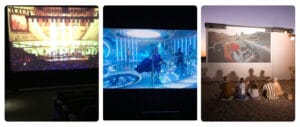
Projector screen paints are not all the same; each type is engineered to serve specific environments and projection needs. White Projector Screen Paint is a reliable all-rounder, providing bright and balanced visuals for offices and classrooms. Black Projector Screen Paint is tailored for high-contrast settings, such as home theatres, delivering deep blacks and sharper details.
For environments with significant ambient light, Ambient Light Rejecting Paint is designed to resist external light interference, ensuring high clarity even in bright rooms. Clear Projector Screen Paint offers a more discreet solution, maintaining the original wall colour while still enhancing projection quality, ideal for design-conscious spaces.
Specialized solutions also include Outdoor Projector Screen Paint, which is resistant to weather and UV exposure, and Short Throw Projector Screen Paint, engineered for ultra-short throw projectors in compact or professional setups. Each type ensures that users can find a paint solution best suited to their space and purpose.
Projector Screen vs Wall

A plain wall may seem like the simplest projection surface, but in practice, it lacks the properties required for high-quality images. Regular walls are often textured, uneven, or coated with paints that reflect light poorly. This leads to washed-out visuals, reduced brightness, and limited contrast.
In contrast, projector screen paints are engineered with advanced reflective and light-controlling technologies. These coatings ensure uniform light distribution, enhanced contrast ratios, and improved picture clarity. Compared to a bare wall, the difference in image sharpness and brightness is significant.
While a plain white wall may suffice for casual or temporary use, anyone looking for professional or long-term solutions will find projector screen paint or screens a far more effective option.
Making the Right Choice
Deciding between a projector screen paint vs screen depends on your priorities and usage. If you need portability, quick setup, or a solution for occasional use, a traditional projector screen remains a reliable option. However, if you want a permanent, space-saving, and customizable solution, projector screen paint offers clear advantages.
Educational institutions and businesses often favor paint for its versatility and ability to create large, functional projection areas. Homeowners, particularly those building dedicated home theaters, appreciate the way projection paints integrate seamlessly into their decor.
The choice is not about which is universally better, but about which option best aligns with your environment, budget, and long-term goals.
Final Words
The projector screen vs paint debate highlights two strong contenders for creating the ideal projection experience. Screens offer simplicity and portability, while paints deliver unmatched flexibility, design integration, and long-term cost efficiency. For many modern users, whether in classrooms, offices, or homes, projection paint stands out as the solution that adapts to diverse needs while maintaining professional image quality.
When making your decision, consider the space, lighting, and intended use. Both solutions have their place, but projector screen paints provide an innovative, future-ready approach that combines practicality with performance. Look for performance certification for example all leading screen manufacturers have this and leading projection paint manufacturers like Smarter Surfaces have performance certification for each product.

